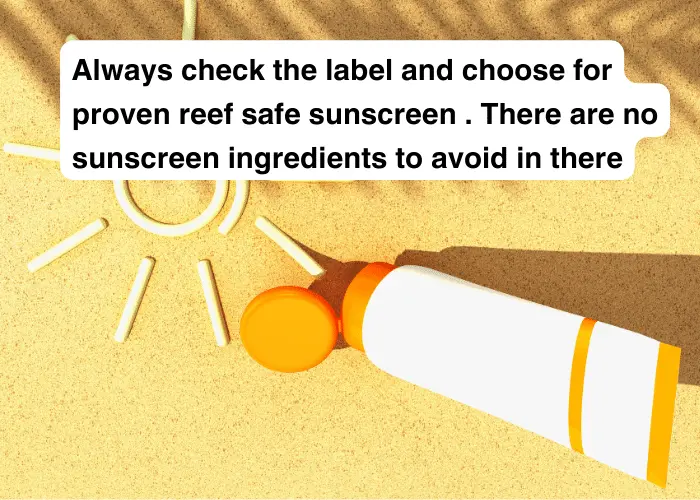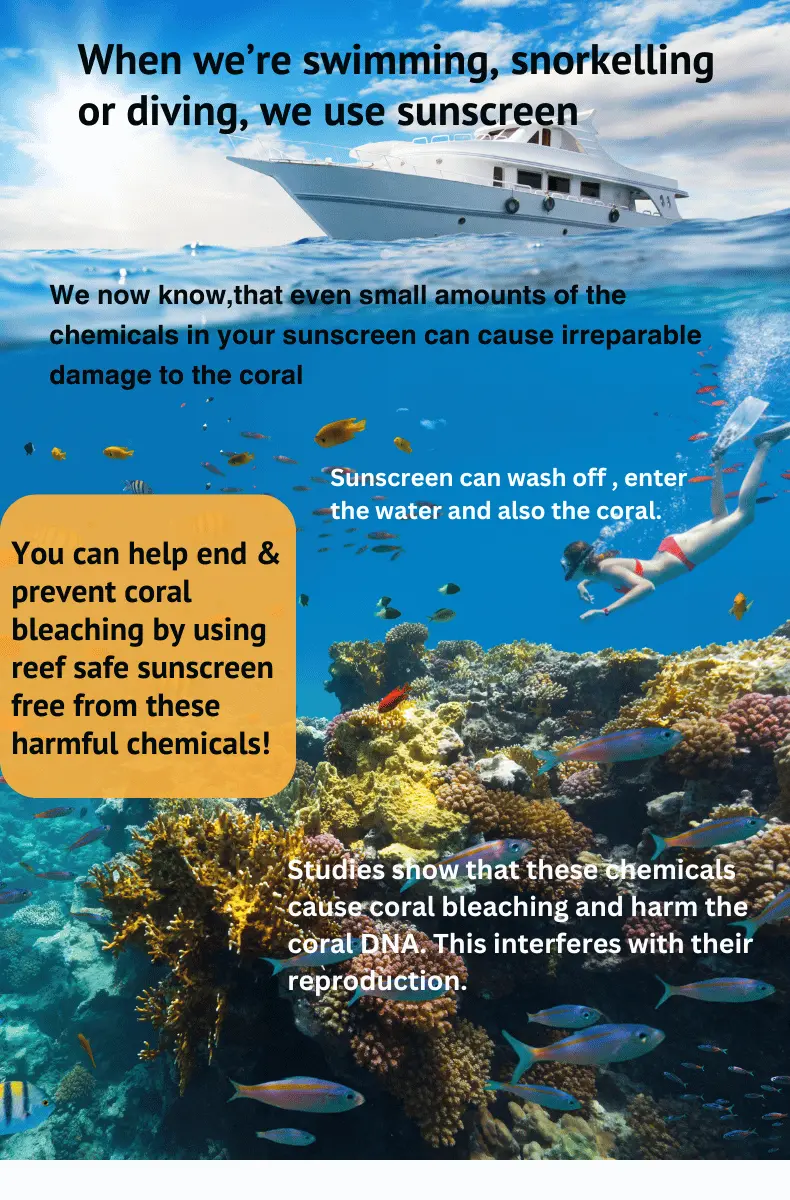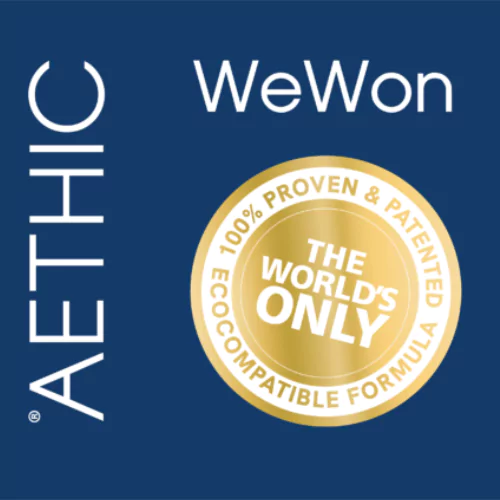Sunscreens are topical products designed to protect our skin from the sun’s damaging ultraviolet (UV) rays. They contain organic or inorganic ingredients that either absorb UV radiation, preventing it from penetrating the skin, or reflect it away from the skin.
Not all sunscreen ingredients are skin-friendly or environmentally friendly. Certain ingredients used in many sunscreens can cause skin irritation, hormonal disruptions, and are toxic to aquatic life.
We will discuss most of the sunscreen ingredients to avoid and the growing concerns about their potential health and environmental impacts.
_____
Among these concerns are :
You’ve probably heard of this one, as it is one of the most mentioned chemicals. Oxybenzone is a chemical UV filter commonly used in sunscreens to absorb and dissipate UV radiation. However, it has been linked to hormone disruption in humans, particularly affecting estrogen levels, and can potentially interfere with reproductive systems.
It has been identified as an endocrine disruptor. Moreover, oxybenzone has been shown to be harmful to coral reefs, (scientists now know why ) as it contributes to coral bleaching and inhibits coral growth, ultimately disrupting marine ecosystems and biodiversity.
To get a full picture of this nasty chemical, one of the sunscreen ingredients to avoid , please read on to see what adverse effects it can cause:
Avobenzone, a common chemical UV filter found in many sunscreens, presents several concerning characteristics that warrant attention. While it effectively absorbs UVA radiation, providing broad-spectrum protection against the sun’s harmful rays, avobenzone’s stability issues under sunlight raise significant concerns. When exposed to UV light, avobenzone can degrade rapidly, leading to decreased sun protection efficacy and potential skin damage. This instability necessitates the addition of stabilizing agents, which may introduce further risks or sensitivities for some individuals. Moreover, avobenzone’s potential for skin penetration raises questions about its systemic absorption and distribution within the body, with studies indicating detectable levels of the compound in urine samples following sunscreen application. Such findings raise concerns about the compound’s potential to disrupt hormone function or exert adverse effects on reproductive health. Furthermore, avobenzone’s chemical structure makes it susceptible to degradation into potentially harmful byproducts, such as free radicals, when exposed to sunlight. These free radicals can induce oxidative stress, damage cellular components, and contribute to premature skin aging or skin cancer development. Additionally, while avobenzone is considered safe for most people, some individuals may experience skin irritation, allergic reactions, or photoallergic reactions upon exposure, further highlighting its potential risks. Concerns also extend to the compound’s environmental impact, with studies suggesting that avobenzone, along with other chemical UV filters, may contribute to coral reef bleaching and marine ecosystem disruption. Overall, while avobenzone plays a vital role in sunscreen formulations, its stability issues, potential for skin penetration, and environmental impact underscore the need for continued research and consideration of alternative UV filters.
Oxybenzone has also been associated with skin allergies and irritation in some individuals. According to a review article published in the Journal of the American Academy of Dermatology in 2014, oxybenzone was identified as a common allergen and irritant in sunscreen formulations, leading to contact dermatitis and other skin reactions. This sensitivity may be exacerbated in individuals with preexisting skin conditions such as eczema or rosacea.
Oxybenzone has been shown to exhibit phototoxic properties when exposed to sunlight. In a study published in the journal Free Radical Biology & Medicine in 2004, researchers demonstrated that oxybenzone undergoes photochemical reactions upon UV exposure, resulting in the generation of reactive oxygen species (ROS) and free radicals. These ROS can induce oxidative stress and damage skin cells, potentially contributing to premature skin aging and increasing the risk of skin cancer.
Oxybenzone poses significant risks to marine ecosystems, particularly coral reefs. Research has shown that oxybenzone can accumulate in coastal waters through various sources, including wastewater discharge and recreational activities. In a study published in the journal Archives of Environmental Contamination and Toxicology in 2016, researchers found that oxybenzone was present at high concentrations in popular reef areas and was linked to coral bleaching, DNA damage, and coral mortality. The mechanism underlying this toxicity involves oxybenzone’s ability to disrupt coral reproduction, inhibit coral larval development, and induce coral bleaching by promoting viral infections.
Oxybenzone has the potential to bioaccumulate and biomagnify in aquatic food chains, posing a threat to marine organisms and human health. Research has shown that oxybenzone can be absorbed by marine organisms, including fish, crustaceans, and mollusks, and accumulate in their tissues over time. In a study published in the journal Chemosphere in 2015, researchers detected oxybenzone residues in various fish species from coral reef ecosystems, highlighting the potential for bioaccumulation and biomagnification along the food chain.
Free radicals are reactive molecules in our bodies that have unpaired electrons, making them unstable. When we say a molecule is “unstable,” we mean that it’s not in a balanced or harmonious state. In the case of free radicals, this instability comes from having an unpaired electron. Electrons like to be in pairs, so when one is left alone without a partner, it creates a kind of chemical imbalance.
To regain stability, these free radicals try to steal an electron from other nearby molecules, causing a chain reaction. This process can lead to damage in cells and tissues because it disrupts the normal functioning of molecules. Essentially, this instability makes free radicals highly reactive and potentially harmful to our bodies.
They can arise from normal bodily processes or external sources like pollution and radiation. When present in excess, they cause oxidative stress, which harms cells and can lead to various diseases such as cancer, heart disease, and Alzheimer’s.
Oxidative stress is like a state of imbalance in our bodies. It happens when there’s an excess of these reactive troublemakers called free radicals. Think of it like having too many bullies on the playground—they start causing chaos and picking fights with other kids (which in our bodies are molecules like proteins and DNA). This constant turmoil damages our cells and tissues. It’s a bit like a small fire spreading quickly in a forest—it can harm everything in its path.
This damage can lead to various health issues, from aging faster to increasing the risk of serious diseases like cancer and heart disease. So, oxidative stress is essentially the result of these free radicals running wild and causing trouble throughout our bodies.
Antioxidants, found in foods like fruits and vegetables, neutralize free radicals and help prevent cellular damage. Understanding and managing free radicals is crucial for maintaining health and preventing disease.
Octinoxate is another chemical UV filter that absorbs UVB rays. Like oxybenzone, it has been associated with hormone disruption, particularly affecting thyroid function. Octinoxate is also harmful to coral reefs, as it can accumulate in reef environments and contribute to coral bleaching, ultimately threatening marine life.
Homosalate is an organic compound used in sunscreens to absorb UVB rays. While it’s generally considered safe in low concentrations, it can disrupt hormone function, particularly estrogen levels, and has been detected in human urine, indicating potential systemic absorption and distribution within the body.
Octocrylene is a UV filter that helps stabilize other sunscreen ingredients and provides broad-spectrum protection against UV radiation. However, when exposed to sunlight, octocrylene can generate free radicals, (see above ) which can lead to oxidative stress and damage to skin cells, potentially accelerating skin aging and increasing the risk of skin cancer.

Next on the list of sunscreen ingredients to avoid is 4-MBC: a chemical UV filter used to absorb UVA and UVB rays. Studies have shown that 4-MBC can disrupt hormone function, particularly affecting estrogen levels, and has been associated with adverse reproductive effects in animal studies, raising concerns about its safety for human use.
Parabens, such as methylparaben and propylparaben, are common preservatives found in many cosmetic and personal care products. Functioning as vigilant guardians against microbial contamination, they prevent the growth of bacteria, mold, and yeast, thereby extending the shelf life of these products. However, their chemical structure bears resemblance to estrogen, a vital hormone in the human body.
This similarity has sparked concerns regarding potential endocrine-disrupting effects, as parabens might interfere with hormonal balance. While scientific research has yielded mixed findings on the matter, ongoing investigations aim to elucidate the precise implications of paraben exposure on human health. Despite their efficacy in product preservation, the complex interplay between parabens and biological systems warrants careful consideration within the cosmetics industry and beyond, hence on the list of sunscreen ingredients to avoid.
Retinyl palmitate is a derivative of vitamin A often added to sunscreens for its antioxidant properties and potential anti-aging benefits. However, in the presence of sunlight, retinyl palmitate can break down and produce free radicals, which can damage skin cells and DNA, potentially increasing the risk of skin cancer and accelerating skin aging.

Nano-sized particles of titanium dioxide and zinc oxide are used in mineral sunscreens to provide physical protection against UV radiation. While larger particles are generally considered safe, nanoparticles have raised concerns due to their ability to penetrate the skin and potentially cause cellular damage, inflammation, and oxidative stress, although more research is needed to fully understand their health effects.
Titanium dioxide and zinc oxide, while commonly used in sunscreens for their UV-filtering properties, raise concerns due to their potential for harm. Despite their efficacy in blocking UV radiation, both minerals possess properties that warrant scrutiny. Nanoparticles of titanium dioxide and zinc oxide, often used for their transparency and smooth texture in sunscreen formulations, have been implicated in skin penetration, raising concerns about their potential to enter the bloodstream and accumulate in organs. This has prompted studies investigating their safety, particularly regarding long-term exposure and potential adverse health effects. Furthermore, the production and disposal of nano-sized particles may contribute to environmental pollution and ecosystem disruption. Concerns also arise from the presence of impurities or contaminants in these mineral filters, which can vary depending on manufacturing processes. These impurities may include heavy metals or other toxic substances, posing additional risks to human health and the environment. Additionally, while titanium dioxide and zinc oxide are touted as safer alternatives to chemical UV filters, their impact on marine ecosystems is not negligible. Studies have shown that these mineral filters can accumulate in aquatic environments, potentially harming marine life and coral reefs. Overall, while titanium dioxide and zinc oxide offer sun protection, their potential for harm underscores the need for continued research, regulation, and consideration of alternative sunscreen options

Fragrance or perfume is often added to sunscreens to mask unpleasant odors or enhance product appeal. However, fragrance blends can contain numerous chemicals, including allergens and sensitizers, which can cause skin irritation, allergic reactions, respiratory problems, and other adverse health effects, particularly in individuals with sensitive skin or respiratory conditions.
PEG compounds are used in sunscreens as emulsifiers, solvents, and penetration enhancers to improve product texture and efficacy. However, they can be contaminated with 1,4-dioxane, a potential carcinogen, during the manufacturing process, raising concerns about their safety for human use.
Phthalates are often used in sunscreens and other personal care products as plasticizers and solvents to improve texture and flexibility. However, they are on the list of sunscreen ingredients to avoid because they can leach out of products and be absorbed through the skin, potentially disrupting hormone function and reproductive development, and have been linked to adverse health effects, including infertility, birth defects, and an increased risk of certain cancers.
Aethic is Free from harmful chemicals:MIT is a preservative used in sunscreens to prevent microbial contamination and extend shelf life. However, it can cause allergic contact dermatitis and skin irritation in susceptible individuals, leading to redness, itching, and inflammation, particularly with repeated or prolonged exposure.
TEA is used in sunscreens as a pH adjuster and emulsifier to improve product stability and texture. However, it can react with other ingredients in sunscreen formulations to form potentially harmful compounds, such as nitrosamines, which are known carcinogens, and can cause skin irritation and allergic reactions in some individuals.
Formaldehyde-releasing preservatives, such as DMDM hydantoin, diazolidinyl urea, and imidazolidinyl urea, are used in sunscreens to inhibit microbial growth and extend shelf life. However, they release small amounts of formaldehyde over time, which is a known carcinogen and respiratory irritant, raising concerns about their safety for human use.
Benzyl alcohol is used in sunscreens as a preservative and solvent to prevent bacterial growth and improve product stability. However, it can cause skin irritation and allergic reactions in some individuals, particularly those with sensitive or eczema-prone skin, leading to redness, itching, and inflammation.
Avobenzone, a common chemical UV filter found in many sunscreens, presents several concerning characteristics that warrant attention. While it effectively absorbs UVA radiation, providing broad-spectrum protection against the sun’s harmful rays, avobenzone’s stability issues under sunlight raise significant concerns. When exposed to UV light, avobenzone can degrade rapidly, leading to decreased sun protection efficacy and potential skin damage. This instability necessitates the addition of stabilizing agents, which may introduce further risks or sensitivities for some individuals.
Moreover, avobenzone’s potential for skin penetration raises questions about its systemic absorption and distribution within the body, with studies indicating detectable levels of the compound in urine samples following sunscreen application. Such findings raise concerns about the compound’s potential to disrupt hormone function or exert adverse effects on reproductive health. Furthermore, avobenzone’s chemical structure makes it susceptible to degradation into potentially harmful byproducts, such as free radicals, when exposed to sunlight. These free radicals can induce oxidative stress, damage cellular components, and contribute to premature skin aging or skin cancer development. Additionally, while avobenzone is considered safe for most people, some individuals may experience skin irritation, allergic reactions, or photoallergic reactions upon exposure, further highlighting its potential risks. Concerns also extend to the compound’s environmental impact, with studies suggesting that avobenzone, along with other chemical UV filters, may contribute to coral reef bleaching and marine ecosystem disruption. Overall, while avobenzone plays a vital role in sunscreen formulations, its stability issues, potential for skin penetration, and environmental impact underscore the need for continued research and consideration of alternative UV filters
One of the significant environmental issues linked to these harmful sunscreen ingredients to avoid, is their destructive impact on marine life, especially coral reefs. When we swim in the ocean, these chemicals wash off our skin and contaminate the marine ecosystem.

Coral reefs, cherished as one of Earth’s most precious ecosystems, are in jeopardy due to environmental pollution, along with the added harm from harmful sunscreen ingredients to avoid and often found in mainstream products. Coral bleaching damages their DNA, deform their young, and even lead to their death.
The damage doesn’t stop at coral reefs. These chemicals can also affect other marine organisms. They can impair the growth and photosynthesis of green algae, induce defects in mussels, damage the immune and reproductive systems of sea urchins, decrease fertility and reproduction in fish, and accumulate in the tissue of dolphins, potentially harming their young.
_____
As we become more aware of the harmful effects of particular sunscreen ingredients to avoid, the demand for safer alternatives is growing. Proven reef safe sunscreens, like those offered by Aethic, offer effective sun protection without the harmful environmental impact.
Aethic offers the world’s only proven and patented reef safe formula, providing an environmentally conscious solution for sun protection. Without any harmful ingredients, the products are safe for pregnant women, as well as for babies and little children older than 2 years. People with sensitive skin can also use their products.
Unlike many sunscreens, Aethic’s products do not contain zinc oxide or titanium dioxide, commonly touted as safer alternatives but still posing potential environmental concern. For more in-depth scientific proof on the safety of Aethic’s sunscreen products, you can visit their scientific proof page.

_____
The unique combination of the 3 above mentioned sun filters makes up the revolutionary patent that was granted to Aethic. Their sunscreen is being sold and endorsed by big brands.




Being environmentally conscious extends beyond recycling or reducing carbon footprints. It also means making informed decisions about the products we use daily, right down to our sunscreen. By choosing proven reef safe sunscreen, we're not only protecting our skin but also contributing to the preservation of our planet's precious marine life.
